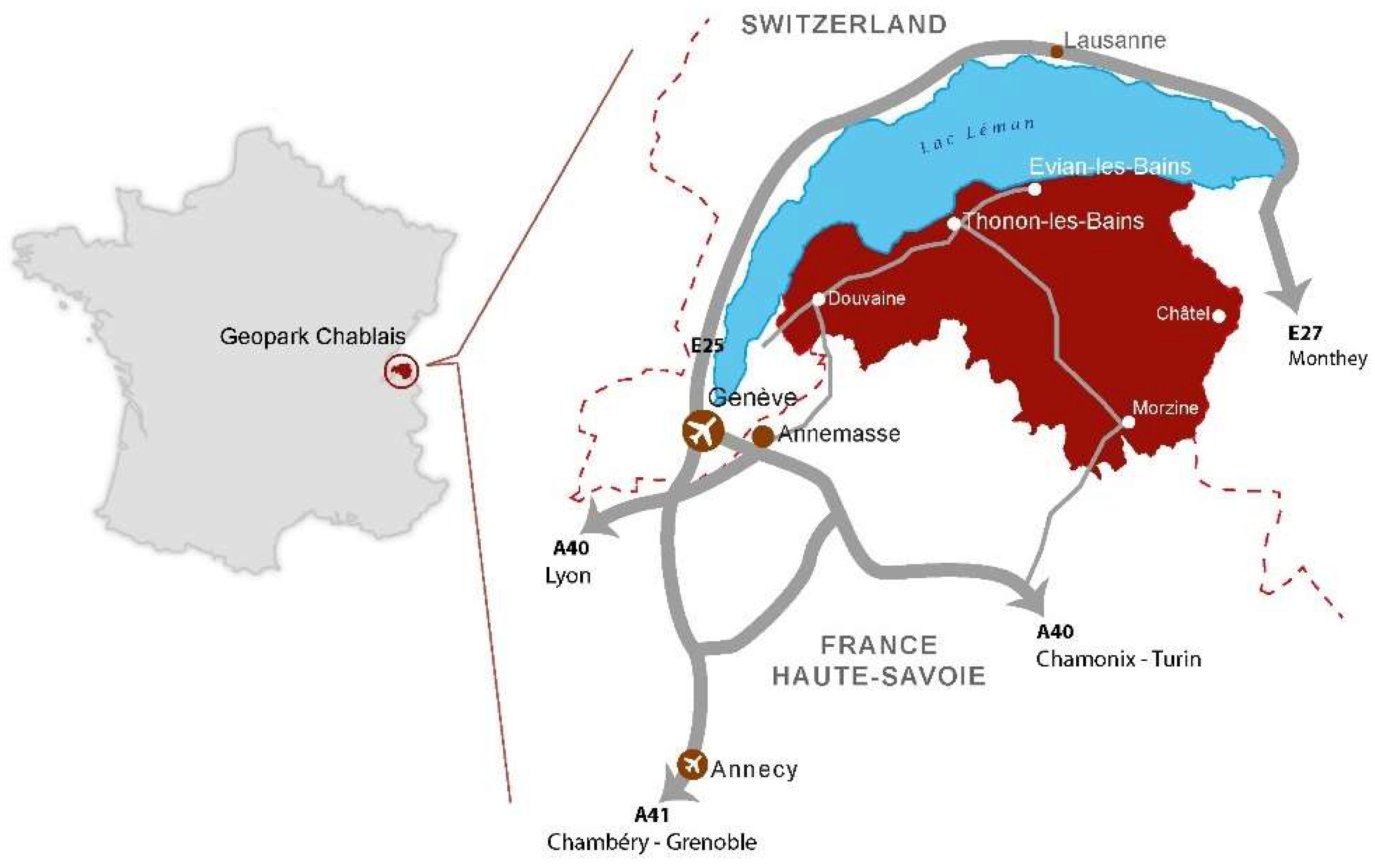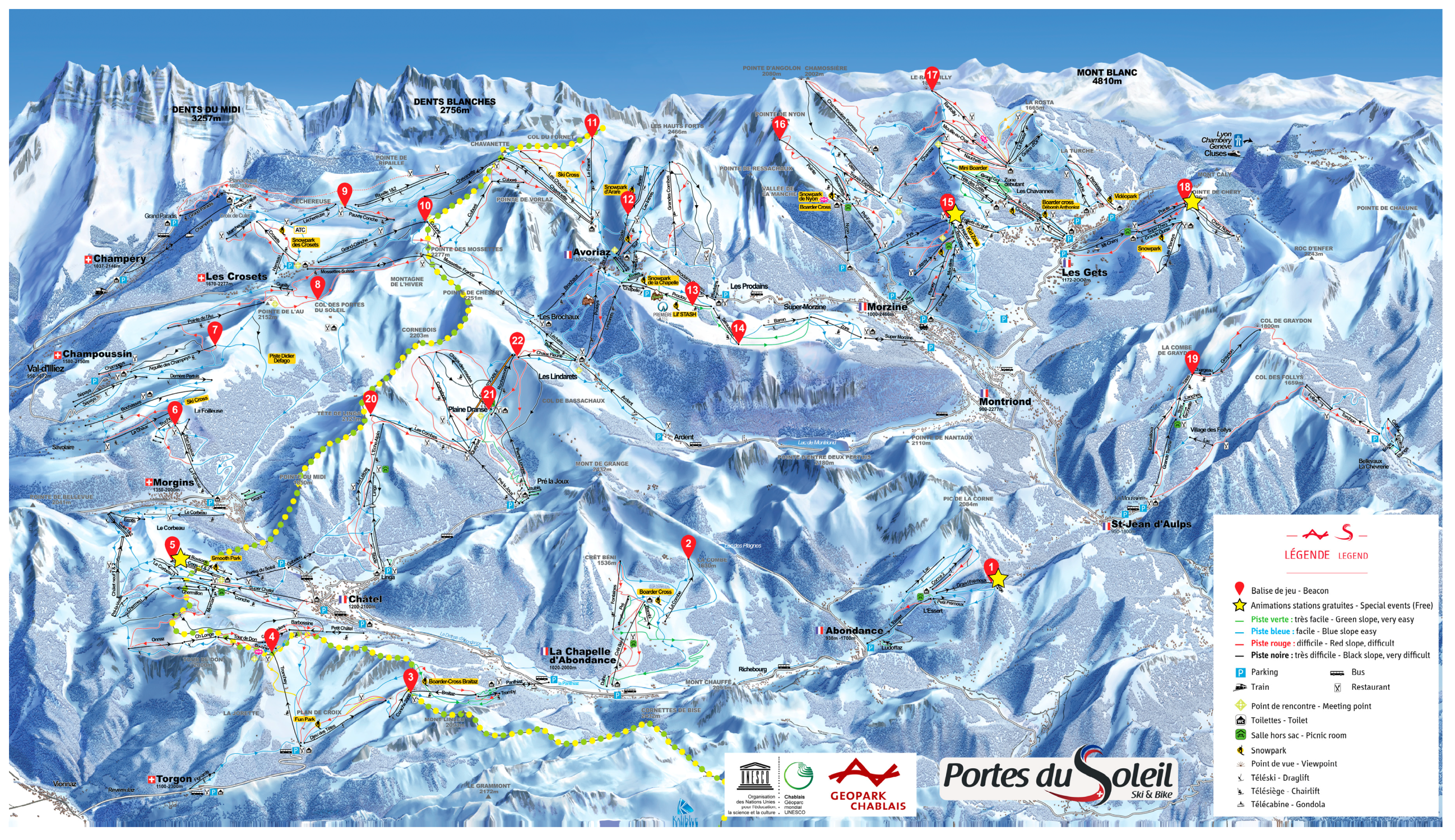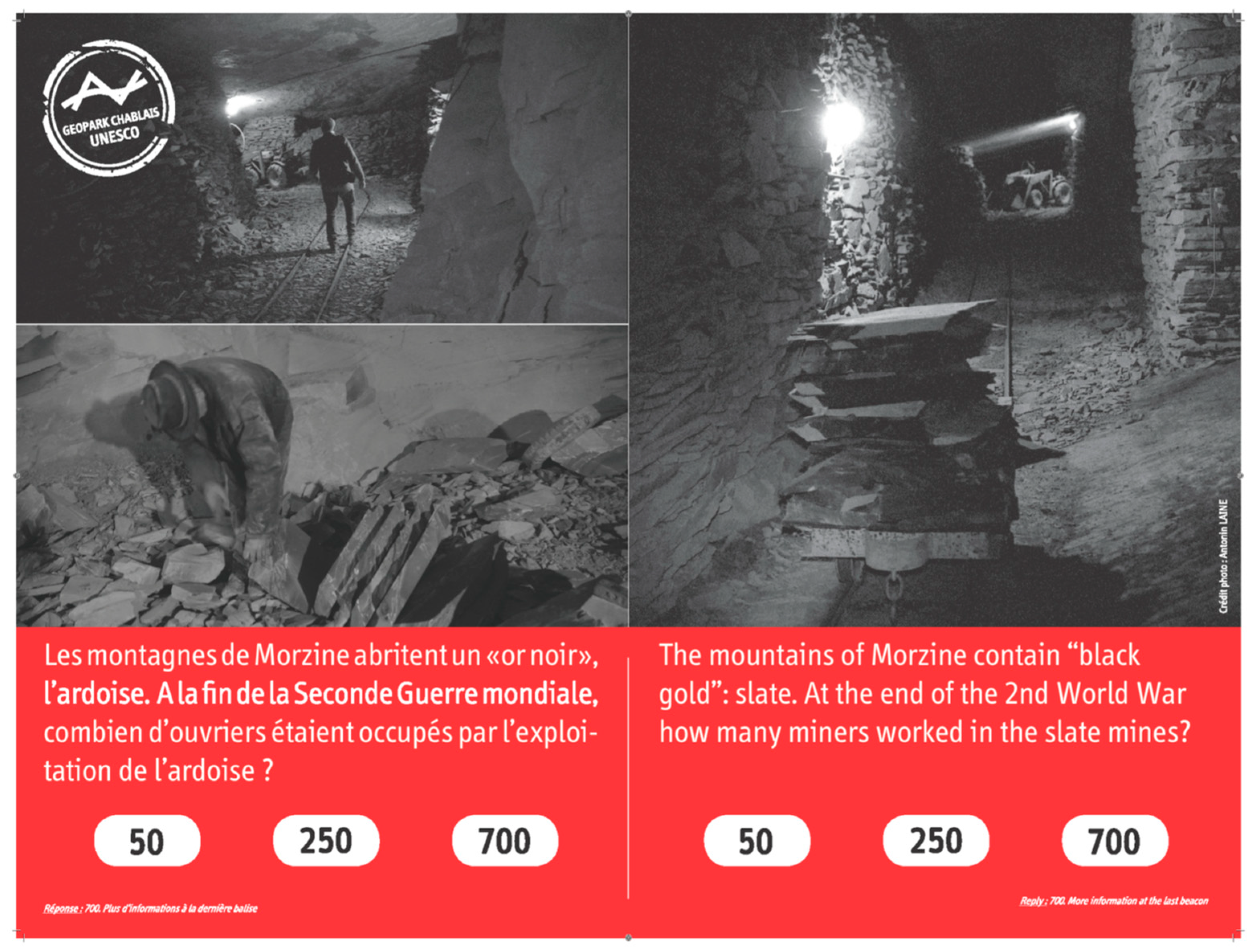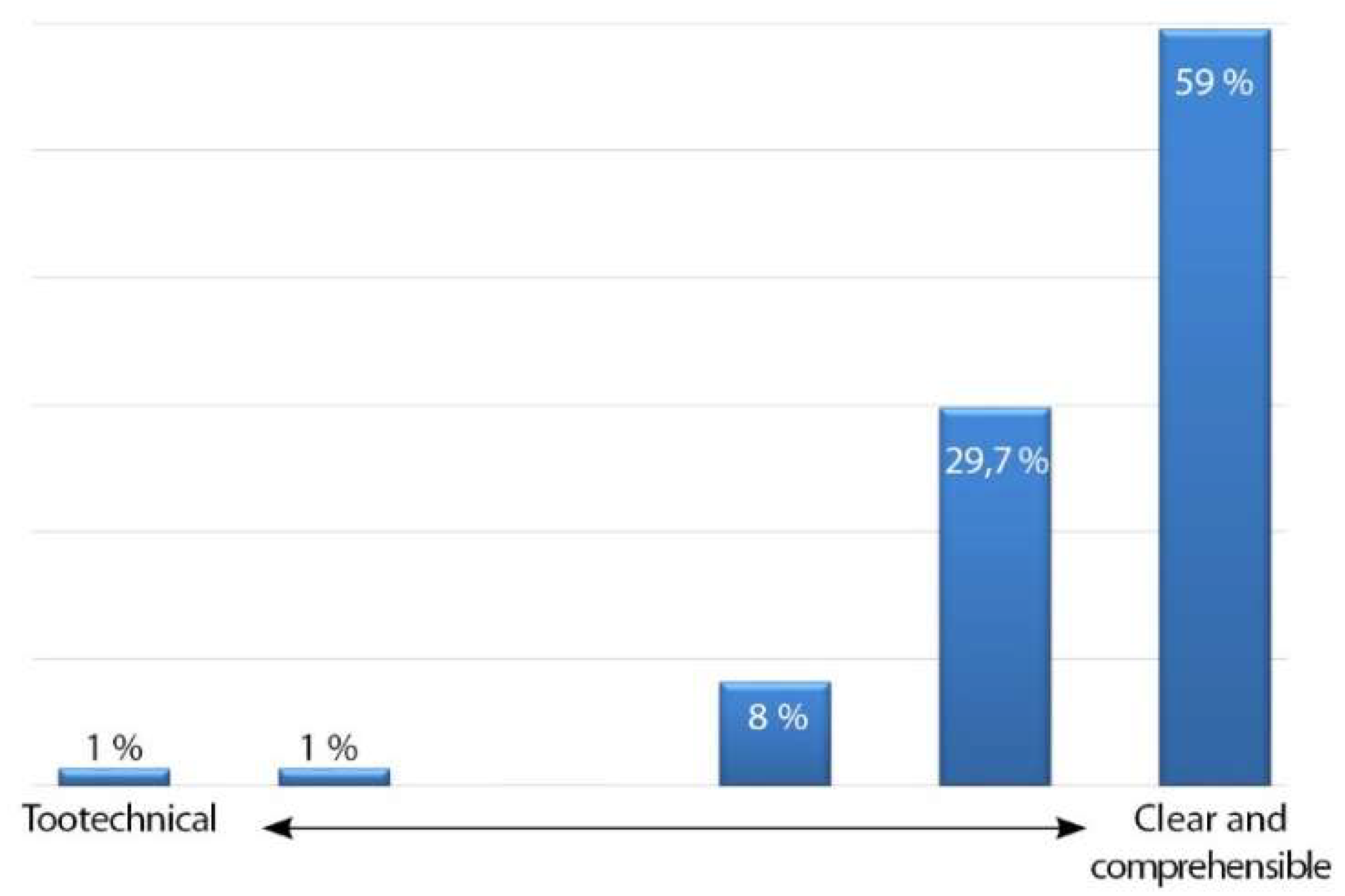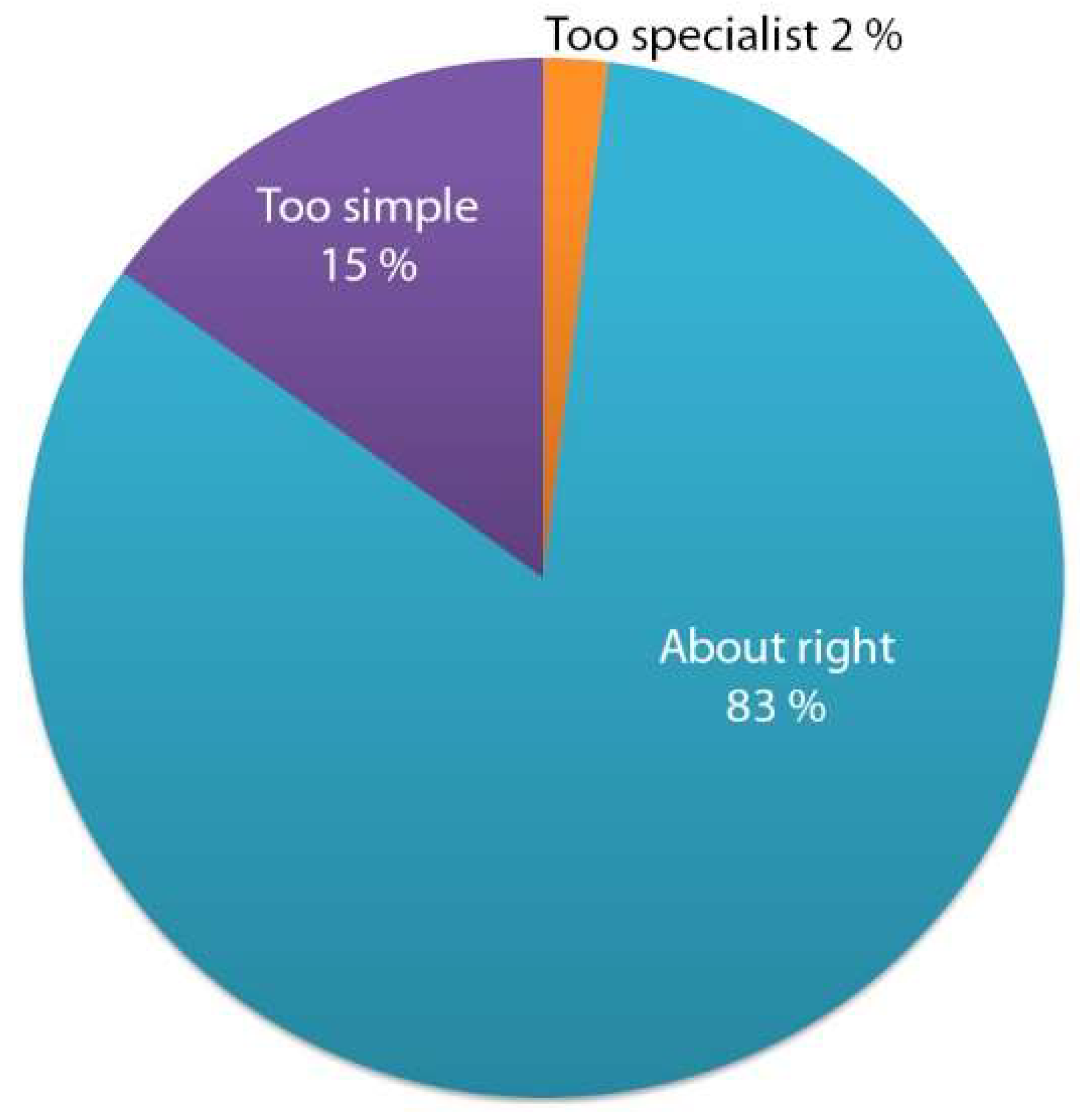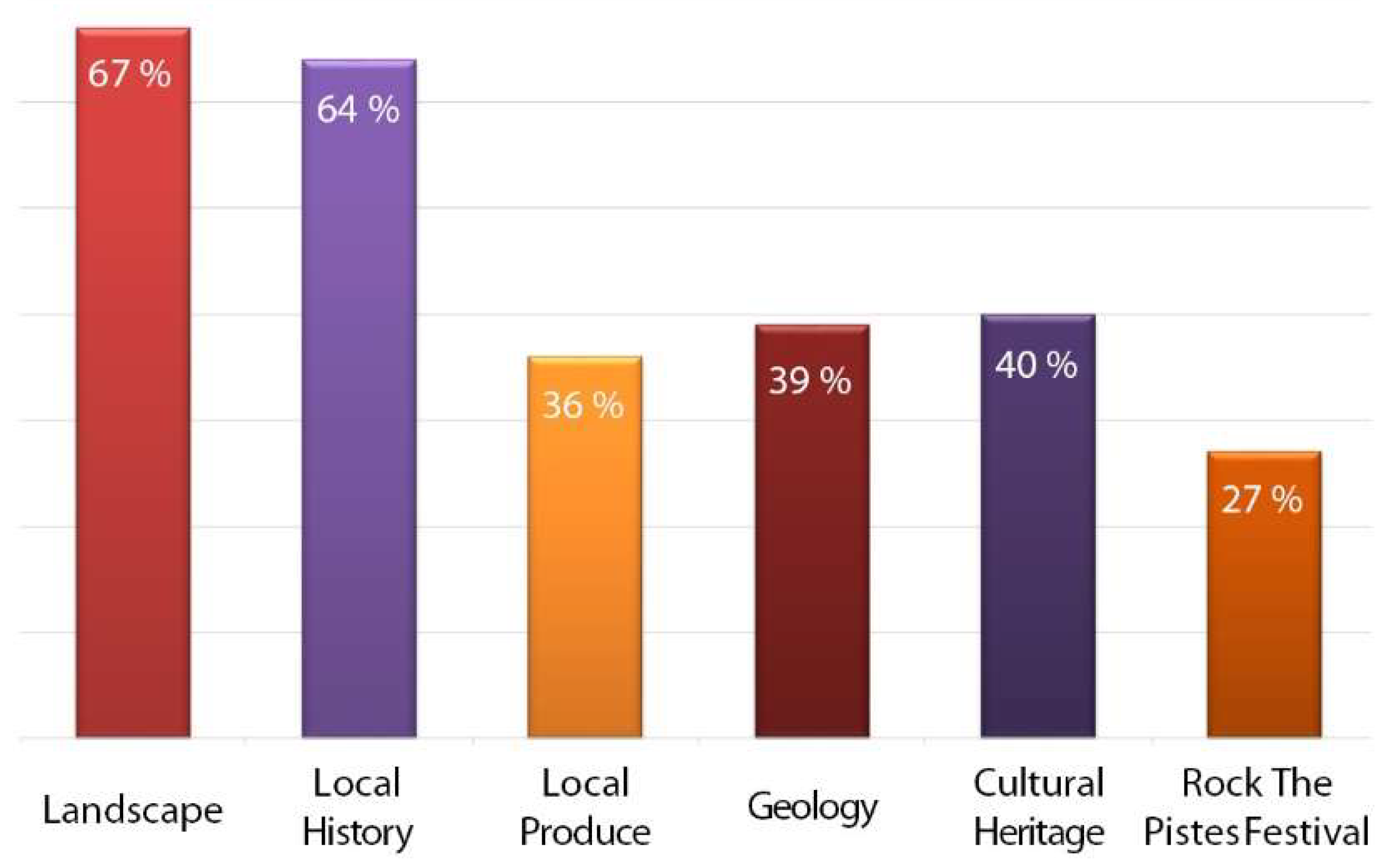1. Introduction
Recent years have seen the significant expansion of the Global Geoparks Network; in 2015, the new label, UNESCO Global Geoparks, under the International Geoscience and Geoparks Programme [
1,
2,
3,
4], was ratified. UGGps are place-based organizations and approach geotourism from a broad perspective. Geotourism and Earth Science communication are two central topics in UNESCO Global Geoparks (UGGps) [
5]. This paper is developed from a conference paper presented during the 14th European Geoparks Conference that took place in the Azores UNESCO Global Geopark [
6]. It considers geotourism and Earth Science communication, taking into account certain inherent features of UGGps that distinguish them from other geotourism sites, notably their spatial extent and their long-term commitment to sustainable development. These aspects result in a broad range of territorial stakeholders contributing to durable heritage conservation and promotion through diverse initiatives.
Many studies have addressed classic interpretation supports such as information panels, themed footpaths and guides [
7]. UGGps by their nature seek to achieve the most effective communication of the geoheritage and cultural heritage of their area by working in professional, multi-disciplinary teams. Freed from the constraints of more traditional structures such as educational institutions and some museums, UGGps are a source of creativity and innovation for the effective transmission to a wide range of audiences, such as school children, the local population, and also visitors.
Within the tourist spectrum, the volume of geotourists is small; however, with the expansion of the UGGp label, some territories, such as those discussed in
Section 2, were pre-existing established tourist destinations. In the case study presented in the second part of this paper, the Chablais UNESCO Global Geopark, France sought to work with “unsuspecting” geotourists. It is an example of a typical innovative outreach event developed in UGGps. Tourists on holiday in the 650 km Franco-Swiss ski area of the Portes du Soleil were not seeking to participate in a cultural activity, nor did they anticipate the investment of time and energy in geoheritage discovery. However, adhering to event management principals, best practice science communication, and drawing on the creativity of the professional UGGp team and its partner the Portes du Soleil, a novel orienteering/treasure hunt game was proposed to a sports public on skis. Building on a 2017 trial event, participants were surveyed using an online questionnaire in order to assess the quality, interest, and success of the 2018 event.
Results demonstrated that despite a potential mismatch between the interest of the target public (a winter sports audience) and the objective of the UGGp to transit heritage knowledge, the ski game was well adapted for these non-geotourists. Not only did participants retain geoheritage information about the area, but 77% were inclined to take part in future UGGp events. This confirms that large numbers of visitors can be reached through simple, well designed actions. Furthermore, the case study demonstrates that the ambition of the Chablais UGGp to cultivate an audience receptive to the Geopark and its other events, as well as to build on events such as this to deepen their knowledge of geoheritage and Earth Sciences, are credible objectives.
2. UNESCO Global Geoparks
UGGps are unique. They are not simply a geosite of interest, or a landscape; they are living territories where stakeholders work together to construct a sustainable future [
1]. UNESCO defines UGGps as “Single, unified geographical areas where sites and landscapes of international geological significance are managed with a holistic concept of protection, education and sustainable development” [
8].
Each UGGp is defined by its specific geoheritage; a collection of identified, assessed, and documented geosites framed within the specific context of the geological and cultural background of each territory. Drawing on the geosites and regional stories, UGGps engage in geotourism for the benefit of the local population and their visitors. They are of particular interest when considering the questions of geotourism and Earth Science communication for two reasons. The first is that geoparks are long term commitments made by territories and their management bodies; the second is their spatial aspect.
Looking more closely at the long-term characteristics of geoparks, this is, in part due to the nature of the UGGp label itself. To obtain the label requires many years of preparation, and then to retain it necessitates the constant engagement of the area concerned. The terms of reference for an UGGp are lengthy, and require not only a strong management structure, visibility and international networking, but crucially, the drawing together of the local community, scientific experts, territorial stakeholders and politicians. Each area awarded an UGGp label undergoes regular revalidation missions to confirm that the territory continues to respect the terms of reference for a UNESCO Global Geopark. Furthermore, geoparks are far reaching; their activities concern geoconservation, geotourism, climate change, natural risks, sustainable development, education and research. It takes time to build networks, to associate and implicate the local population, and to communicate. Parties need to share common goals and construct long term projects that remain relevant even as regions undergo political renewal. Geoparks embrace a holistic approach, providing a narrative for the territory; within this context individual geosites are valorized similarly to other natural and cultural heritage. The stories are not told once; they are echoed, amplified, recast and retold, and crafted for local audiences, reworked for visitors, reformulated with school children.
Returning to the second defining feature of UGGps, it is their spatial extent that also sets them apart. Their commitment and activities are intertwined with a region and its people. These territories cover a coherent managed area with towns, villages, commercial and industrial activity, but also natural and protected space too. They have their own culture, identity and intangible heritage. An UGGp does not position itself for a narrow, niche market; rather, it seeks to educate and inform the local population, and create ambassadors for the preservation of its many natural and cultural heritages, to train local stakeholders to transmit the stories and authentic experiences of the area. A region that fully commits to a long term sustainable development plan, delivered by an effective management structure, will have strong social and political associations and a clear commercial position. Reynard and Giusti, (2018) [
9], in their review of the concept of “landscape”, examined various definitions and amongst others identified the “political” dimension associated with the spatial notion of the territory.
Smaller Geoparks cover several hundred square kilometres (for example, the Hong Kong UGGp extends across 150 km2), but UGGps can extend over several thousands of kilometres (such as Katla UGGp which covers 9542 km2). These placed-based organizations do not promote a single geosite that is promoted by one council or a particular company; instead, schools, the public, geotourists, and specialists are offered the opportunity to discover a web of geosites and experiences framed in the context of the regional geosystem. These geosites are interpreted and communicated, but are also conserved and monitored. Together, they are linked to a regional interpretation, and can provide the opportunity to develop deeper Earth Science content. In this regard, there is no comparable international label or approach that capitalizes upon the Earth sciences in this manner.
The maturing of the Geopark concept has been evidenced through the ratification of the UNESCO Global Geopark label in 2015, and through the growing numbers of UGGps worldwide, all members of the Global Geopark Network [
10]. It is also seen through the broadening of the international reach of the UGGp label. For example, in 2018, territories in the Russian Federation, Nicaragua and Luxembourg submitted new UGGp applications. The label is also experiencing a diversification in the inherent nature of its member geoparks. Early geoparks, and indeed many geoparks, have engaged in rural development [
11,
12]. Today however, the members of the Global Geopark Network demonstrate the strength and interest of this label that has been successfully applied to diverse territories. For example, Pollino UGGp, Italy, contains naturally hazardous materials [
13]. Other geoparks such as Hong Kong UGGp, China the Chablais UGGp, France and the English Riviera UGGp, United Kingdom are not only densely populated territories, but are already popular tourist destinations [
6,
14,
15,
16].
3. Geotourism
As a form of sustainable tourism that is considered to specifically focus on geology and landscape, geotourism has been the focus of research for over twenty years [
17]. Various definitions are employed by different authors and include those of Hose [
18], and of Newsome and Dowling [
19]. These definitions have evolved over time from a niche tourism focused on geological heritage and geoconservation, to incorporate notions such as education and sustainability [
20,
21].
A contrast exists with those definitions developed by professionals from place-based organizations, such as UNESCO Global Geoparks, where additional references are made to commercial and political elements [
5,
22]. This is a natural consequence of the manner that an UGGp engages in a territory, as discussed in the previous section. As highlighted by McKeever et al. (2010) [
2], it is the creation of opportunities in association with the non-restrictive conservation of geological heritage that is at the heart of Geopark activities. UGGps propose different forms of geoheritage transmission, from the education and training of the local population, to discovery projects for schools and layered tourism products adapted for different audiences. Professionals in science, education, tourism and marketing, amongst other subjects, collaborate to deliver Geopark strategy, including geotourism. Hart Robertson (2015) [
23], examined tourism marketing, and noted that heritage interpretation adds value to place branding. UGGps capitalise on this added value opportunity, because they are naturally engaged in heritage interpretation, and because Geoparks actively market their territories as sustainable tourism destinations. As a component of a long-term strategy, Geopark professionals situate activities such as geotourism in such a commercial framework which includes its marketing.
UGGps reflect the quality inherent to a UNESCO label, and are subject to various assessments and revalidations. Also, through the Global Geopark Network, UGGps cooperate to promote best practice. However, for success in the long term, UGGps need to generate the interest, engagement and trust of decision makers. They strengthen their longevity by demonstrating their relevance to stakeholders, politicians and visitors. In part this is achieved through successful geotourism initiatives to ensure the attractiveness of the Geopark tourist offers and their financial viability. It is inherent to geotourism activity in UGGps that wider political and commercial considerations emerge, in coherence with territorial sustainable development objectives.
4. Earth Science Communication in UGGps
The geoheritage and stories of a territory are communicated following a structured approach. Each UGGp has an inventory of its geosites with information about sites suitable for education, tourism and scientific purposes. Strategy is developed to identify which information to communicate, the target audiences, and an outline of interpretation approaches. As discussed by Macadam (2018) [
24], skill and reflection is required for the communication of the Earth Sciences and heritage interpretation. Previous authors, notably Stewart and Nield (2013) [
25], have discussed the low-level of knowledge of the Earth Sciences amongst the population. Public events in the Chablais UGGp over the last three years have attracted hundreds of participants, and anecdotally, Geopark staff have confirmed these observations. In general, there is a limited understanding concerning the source of everyday materials, natural hazards, and even fundamental notions such as the water or carbon cycles. More abstract concepts, such as deep geological time, the deformation of rocks during orogenesis, or the notion of continual evolution of our planet, are even less familiar.
Within the UGGp framework, there is the possibility to provide interpretation of geosites, as well as actions and activities, to communicate the geological and cultural interest of a territory and its regional context. As ambassadors for Earth Science, there is also a responsibility to convey basic information, so that engaged visitors and the local population develop a general knowledge of the Earth Sciences. With the local population in particular, UGGps can repeatedly propose events that permit knowledge to be reinforced and developed. This empowers the local population, permitting them to reclaim their heritage with confidence. It encourages stewardship for the future.
In the Chablais UNESCO Global Geopark for example, the accredited Geopark guides undergo training in basic geological concepts. These self-employed, qualified mid-mountain and heritage guides develop an additional palette of skills linked to reading the landscape, recognizing and being able to interpret the principal rocks units, and linking observations to illustrate the geological evolution of the area [
26]. Not only does this permit them to propose interpretation activities, these guides today are also a force for new initiatives in the area.
Visitors appreciate geosites on different levels. Niche earth science tourists seek to enrich their knowledge; other visitors are receptive to earth science concepts delivered as part of a wider tourism experience [
21,
27]. As a result, to meet the various interest and knowledge demands of their visitors, UGGps develop layered responses. An example was presented by Wang et al. (2015) [
13], whereby graded interpretation material in Hong Kong UNESCO Global Geopark was presented as a function of the visitors knowledge. Other approaches involve mixing the type of interpretation, from public talks by specialists, to guided visits by Geopark guides, to exploring the heritage through the five senses or through games.
Some Geoparks, such as Chablais UGGp, are thriving pre-existing tourist destinations that attract hundreds of thousands of tourists each year. These visitors are not arriving in the territory for a cultural experience and with time set aside to learn; they are primarily attracted by the natural environment and the mountain and lake sports on offer. In addition to the previously identified audiences, particular interpretation tools are developed to connect with, and enrich the experience of, the “unsuspecting” geotourist. This includes sharing the UNESCO Global Geopark label, as well the heritage riches of the territory. It is this particular audience that was the focus of the recent case study detailed below in the final section of this article.
5. Case Study: Sustainable Tourism in the Chablais UNSECO Global Geopark
5.1. Context
The Chablais UGGp is located on the border with Switzerland and lies between Lake Geneva and Mont Blanc. This territory extends across 870 km
2 and is characterized by a natural, mountainous Alpine landscape in the south, and lower altitude, rolling hills along the lake shores to the north, (
Figure 1). Comprising a number of well-known tourist destinations such as Morzine, Les Gets and Chatel for winter sports, and Evian, Thonon and Yvoire for summer lake-based holidays, the area has a thriving economy and a higher population density than the French national average (154 people per km
2, 2016). In 2016, the area recorded 4,419,800 bed nights in the summer and 6,933,600 bed nights in the winter, demonstrating the established importance of tourism for the area [
28].
A management review in 2016 underlined that the majority of the Geopark outreach events were held in the summer months. In part this was due to the seasonal accessibility of geosites, but also due to the Geopark choices, for example investing in the training of local guides who offer an array of Geopark outings largely outside the winter months.
The Geopark has built a network with partners from through the Chablais that adhere to shared sustainable development values. Amongst these partners is the Franco-Swiss Portes du Soleil association, which groups together 12 mountain villages in the two countries, linked together by hiking and biking trails, ski slopes and chairlifts. Visitors can explore this natural space in summer by walking and mountain biking, and also in winter across the 650 km-long ski runs. Chablais UGGp has for a number of years worked together with the Portes du Soleil in summer events, but the two partners agreed to create a new winter event on the slopes for 2017.
5.2. Objectives and Construction of the Outreach Event
The principal objectives of the event were to:
Raise awareness around the UNESCO Global Geopark label;
Promote the natural and cultural heritage of the Chablais;
Encourage visitors to return in summer.
To be successful, the event needed to encourage participants to open their eyes and appreciate the landscape and its resources in a different way. However, it was not simply a question of rolling out a tried and tested heritage interpretation tool; the event itself imposed a number of logistical constraints. The most significant was the nature of the public. It was a sporting audience that had chosen an exclusive holiday in order to experience speed and sensation. They had not chosen a cultural pursuit, one that required time and investment. The second restriction was the date; the event was scheduled for late January, the height of winter with potentially poor weather and low temperatures. This date had to be maintained, as the calendar of events for the rest of the ski season was already established. Finally, the ski domain covers more than 650 km of pistes. This presented a resource challenge to the geopark in terms of creating an impact, and also event management.
To best meet the varied objectives, and to maximise the geopark’s impact without a substantial physical presence, the concept of an orienteering/treasure hunt game was developed. It was elaborated by drawing on the complementary skills of both the Chablais UGGp team, with its geoheritage knowledge of science and communication expertise, and with the event management experience of the Portes du Soleil events team. Working together, the event was designed in line with professional event management practices [
29]. The aim was to encourage participants, with the support of a game card to explore the area on skis and to “collect” local curiosities and anecdotes along their route (
Figure 2). In this way, skiers continued to practice the sport that they had come on holiday to enjoy, but passed the time on their skis in a novel way. Having collected a minimum number of panels, skiers were invited to the final beacon to meet the Portes du Soleil and Geopark teams. The final challenge was to pass a geopark quiz, with questions addressing the themes discovered during the day, and then to validate the game card. A tasting of local cheese was offered at this point. Returning to a central point was logistically useful for both the Portes du Soleil and the Chablais Geopark. It permitted a count to be made of the number of participants completing the game, and enabled questions to be posed with regard the aims, construction and success of the event.
A number of beacons were identified and displayed on a special game map; each was linked to a Geopark game panel (
Figure 3). The panels were thematically linked to the village where they were located, and relayed either geological, cultural or even gastronomic information. This was done in the form of a short question or anecdote that presented unexpected information in an accessible format. In order to effectively communicate, careful preparation was undertaken. Despite the relative simplicity of the final questions, their development was one of the most time-consuming aspects of the whole event. The questions had to be short enough to be read, sufficiently entertaining to stimulate players to continue, dense enough to convey a body of information, but not so dense as to lose the public. In addition, the anecdotes had to be in plain language, excluding all jargon, and needed to be in French and English. All this had to be done whilst rendering a panel that was aesthetically appealing.
Participation in the game was free, but necessitated a ski pass that extended across the whole 12 resort domain. In the eventuality that skiers encountered the panels by chance, they would not necessarily hold the ski pass required to return to the final Geopark stand to ask any questions or seek answers. The Geopark did not want to leave anyone in a position of difficulty, and therefore, it was decided to include answers in the configuration of the panel. This was done by discretely incorporating the response in a small size font at the bottom of the panel, to the left (French) and right (English),
Figure 3.
5.3. Results
During the 2017 edition, the game comprised 10 beacons spread amongst the 12 ski resorts. More than 500 people visited the Portes du Soleil and Chablais UGGp stand. Of these, 265 people completed the game; the rest were attracted by the final stand. Most players visited at least 5 beacons and won the first level of prize: a free 1-day ski pass for the Portes du Soleil. Five participants planned and managed to complete the whole circuit in the allotted time. There was diversity amongst the players, ranging from locals, day trippers, and also holiday makers from France, Switzerland, and England. Participants anecdotally enjoyed the event and considered that they had done something fun, learnt something new, and explored the area in a different way. The advantage of the event proposed was that upon completing the game, participants were able to exchange with geopark staff, probing deeper into themes of particular interest and gaining insight into specific features of the area. The discussions were also used as a platform for proposing other geopark products, such as walks with the geopark guides, or visits to partner sights.
During the geopark quiz, which was presented in an informal oral manner at the end of the event, participants displayed a good level of recall. Generally, participants were motivated to participate in other Geopark events, and also to return in summer, one of the aims of the event.
In 2018, the event was repeated, although some minor changes to the format were made. For example, it was decided to increase the number of panels in the game area from 10 to 22. Also, in order to better quantify the impact of the event, a questionnaire was developed by the two partners. Out of 265 total participants, 104 replied to an online questionnaire. This result was considered significant, as 92% had participated with friends or family.
The results provided interesting feedback. For example, 44% of respondents had already heard of the UNESCO Global Geopark label prior to participating in the game (which confirms the visibility of the Geopark within the territory). However, as the questionnaire was completed on-line, from a critical perspective it is not known if the public had replied in such a high percentage because of the familiarity of UNESCO, rather than the Global Geopark label per se. Generally, 90% enjoyed playing the game and 77% would consider participating in a future edition.
When considering the panels, the feedback confirmed that the considered approach and careful preparation achieved the goal: to effectively convey information about the geosites (
Figure 4). Participants considered that the panels were written in plain English and French, and that the technical level of the anecdotes were extremely well-suited to the profile of the participants (
Figure 5). In terms of the information presented to the public, it was overwhelmingly the landscape and local history that interested participants the most (67% and 64% of the respondents), as was also identified by Pralong, 2009 [
25]. A result that surprised the team was that 39% of participants were interested in geology, almost identical to the 40% that were interested in cultural heritage (
Figure 6). Finally, looking at the profile of the participants, 87% enjoyed sport and 62% walking, the two most popular responses to the “What do you do in your spare time” question. This was reasonable, considering the game took place in the heart of one of the world’s largest ski areas at the height of winter.
6. Discussion and Conclusions
With the high level of responses to the questionnaires, it is confirmed that, given the constraints and challenges posed by the circumstances of the event, the game format was a highly successful solution and was well adapted to the target public. The time invested in the reflection and development of the event was justified by the overall satisfaction of the participants, as well as their high ratings concerning the contents of the game panels. It was particularly important that the event was concluded at a manned Geopark—Portes du Soleil stand, where participants had the opportunity to discuss subjects of interest, and for certain players, to delve into the detail of the geology and geosites of the region.
The event provided an introduction for many participants to the UGGp concept, and provided the unsuspecting geotourist with their first experience of geotourism. The Chablais UGGp positioned itself to accompany these visitors onto the next level of activities, offering greater heritage interpretation content either through its own activities, or through partners. Finally, it was important for the Geopark to have a partner such as the Portes du Soleil with shared sustainable development objectives, who could also bring complementary skills to the event, such as the logistics of working across the large ski area.
This paper has shown that UGGps with their long-term nature and spatial manifestation across a territory lead to the development of a geotourism associated with political and commercial components. In addition, UGGps propose geotourism offerings seeking to deepen the publics’ knowledge of geoscience, as well as to promote territorial geosites, cultural sites and regional stories. Practical case studies, such as that undertaken in the Chablais UNESCO Global Geopark, demonstrate that large numbers of visitors can be reached with simple but well-constructed events. Careful preparation provided a very effective communication of territorial geosites and Earth science concepts to an audience of non-geotourists. As a Geopark with a layered approach to transmission of information, the Chablais UGGp considers that outreach to this type of public is fundamental. Its ambition is to accompany these visitors in a deeper discovery of the territory and to ensure the continued stewardship of the heritage of the Chablais.
